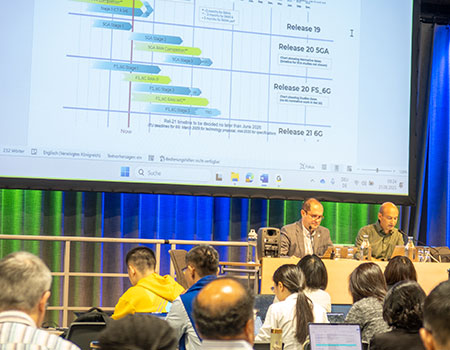HSPA+ is now mainstream, says GSA
Jan 26,2011
January 26, 2011
Newly updated reports published by the GSA (Global mobile Suppliers Association) confirm the continuing strong performance of mobile broadband services enabled by HSPA-based systems across the world.
Taken from the GSA News Release...
The introduction of evolved HSPA systems – HSPA Evolution, commonly referred to as HSPA+ was the major trend in 2010. HSPA+ networks supporting up to 42 Mbps peak downlink data speed are market reality, and some operators are already preparing to introduce the next evolutionary step of 84 Mbps.
Network data speeds are rapidly evolving:
Alan Hadden, President of the GSA, said: “HSPA+ is now mainstream. This has been achieved in only 23 months since the first HSPA+ system was commercially launched. The recent trend was for operators introducing mobile broadband services to launch with HSPA. Most operators entering the market today are going straight to HSPA+.”
HSPA+ systems enable operators to deliver higher capacities and performance levels and contribute to an improved user experience of mobile broadband. 148 HSPA operators, i.e. approaching 40%, have committed to HSPA+ network deployments in 67 countries. A total of 103 operators i.e. more than 1 in 4, have commercially launched HSPA+ systems, in 57 countries.
Approximately 1 in 8 HSPA operators have committed to deploy 42 Mbps DC-HSPA+ capabilities on their networks. In addition to 13 systems already commercially launched as mentioned above, the GSA reports confirm at least an additional 32 operator commitments to deploy DC-HSPA+ technology.
5 operators have committed to the next HSPA Evolution step of 84 Mbps, which can be realized using a combination of DC-HSPA+ (64QAM) and MIMO. 84 Mbps systems and devices are expected to be commercially introduced in 2012.
The updated reports from GSA are available as free downloads to registered website users via the links on www.gsacom.com
About GSA
GSA (Global mobile Suppliers Association) represents GSM/EDGE/WCDMA-HSPA/LTE suppliers, providing reports, facts, analysis and information explaining market developments and trends. GSA-organized seminars facilitate enhanced dialog between operators, members and developer communities.
Newly updated reports published by the GSA (Global mobile Suppliers Association) confirm the continuing strong performance of mobile broadband services enabled by HSPA-based systems across the world.
Taken from the GSA News Release...
The introduction of evolved HSPA systems – HSPA Evolution, commonly referred to as HSPA+ was the major trend in 2010. HSPA+ networks supporting up to 42 Mbps peak downlink data speed are market reality, and some operators are already preparing to introduce the next evolutionary step of 84 Mbps.
Network data speeds are rapidly evolving:
- 247 HSPA networks (65%) support 7.2 Mbps or higher peak downlink capability
- Over 35% of HSPA operators have launched HSUPA for fast data uploading performance
Alan Hadden, President of the GSA, said: “HSPA+ is now mainstream. This has been achieved in only 23 months since the first HSPA+ system was commercially launched. The recent trend was for operators introducing mobile broadband services to launch with HSPA. Most operators entering the market today are going straight to HSPA+.”
HSPA+ systems enable operators to deliver higher capacities and performance levels and contribute to an improved user experience of mobile broadband. 148 HSPA operators, i.e. approaching 40%, have committed to HSPA+ network deployments in 67 countries. A total of 103 operators i.e. more than 1 in 4, have commercially launched HSPA+ systems, in 57 countries.
- 79 commercial HSPA+ networks support a peak downlink data speed of 21 Mbps using 64QAM modulation, delivering a typical user experience up to 8 Mbps (depending on device capability)
- 11 commercial HSPA+ networks support 28 Mbps utilizing MIMO technology
- 13 commercial HSPA+ networks support 42 Mbps, which is achieved by combining 64QAM and doubling the bandwidth (DC-HSPA+)
Approximately 1 in 8 HSPA operators have committed to deploy 42 Mbps DC-HSPA+ capabilities on their networks. In addition to 13 systems already commercially launched as mentioned above, the GSA reports confirm at least an additional 32 operator commitments to deploy DC-HSPA+ technology.
5 operators have committed to the next HSPA Evolution step of 84 Mbps, which can be realized using a combination of DC-HSPA+ (64QAM) and MIMO. 84 Mbps systems and devices are expected to be commercially introduced in 2012.
The updated reports from GSA are available as free downloads to registered website users via the links on www.gsacom.com
About GSA
GSA (Global mobile Suppliers Association) represents GSM/EDGE/WCDMA-HSPA/LTE suppliers, providing reports, facts, analysis and information explaining market developments and trends. GSA-organized seminars facilitate enhanced dialog between operators, members and developer communities.


 Partners News
Partners News 




